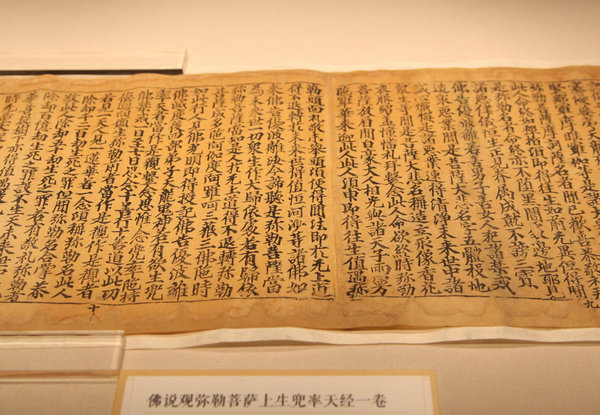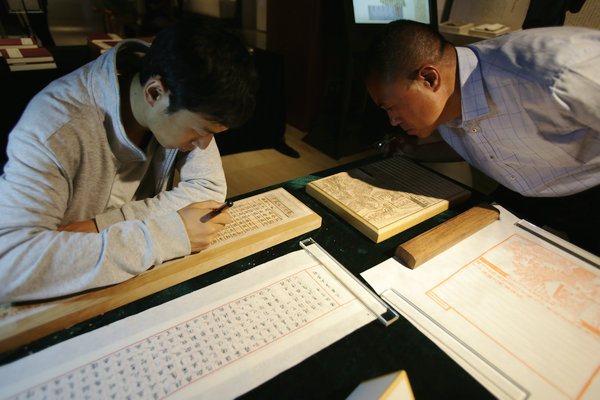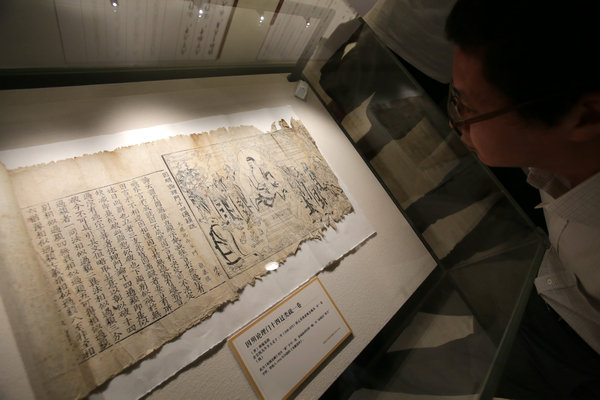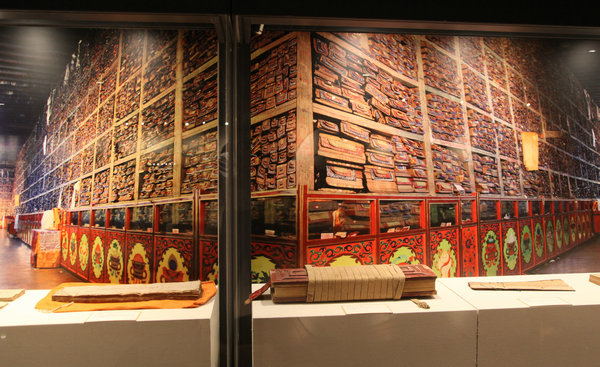
Called “national treasures” by scholars, the texts are highlights of an exhibition of some 100 ancient and classic books from across the country, being held at the National Library of China.
One of the exhibits is a printed version of Mile Shangsheng Jing, one of the three sutras of Maitreya, the future Buddha. Dating AD 927 during the Five Dynasties and Ten Kingdoms (AD 907-960), it is the second-earliest surviving printed document that has been found in China.
Diamond Sutra, the world’s earliest printed book from China, is, however, not on display at the current exhibition. The Tang Dynasty (AD 618-907) copy of the Diamond Sutra, found in one of the Dunhuang caves in 1907 by Hungarian-British explorer Aurel Stein, is now part of the British Library.
The Beijing show has a Diamond Sutra copy that is not dated but has been traced back to the early 10th century by researchers at the national library. Among other rare books on display is a mid-10th century copy of Mile Xiasheng Jing, one of the three Maitreya sutras.

The books were purchased from private collectors and added to the national library’s collection last year after they emerged in the art market.
They are the latest examples of China’s efforts over nearly a decade to catalog and restore key ancient books.
The Ministry of Culture launched in 2007 a preservation project of ancient books that are defined as writing materials before the end of the Qing Dynasty (1644-1911).
An essential part of the ministry’s project has been the national-level cataloging of precious written records on various mediums, including oracle bones and bamboo sheets, and in Mandarin and other languages, including foreign. The catalog has expanded a few times and the latest update in May took the list to 12,274 items in total.
The current exhibition at the national library also has a selection of the new entries. These exhibits not only showcase ancient Chinese wisdom but also show the technical progress in restoring classic writings.

Meanwhile the number of restoration professionals has grown from less than 100 in 2007, when the preservation project started, to more than 1,000 today, according to Zhang Zhiqing, the national library’s deputy director.
Zhang is also the deputy director of the National Center for Preservation and Protection of Ancient Books.
He says these professionals have a master’s degree in ancient book preservation, jointly offered by the center, three universities and the Chinese Academy of Social Sciences, a think tank.
He adds that 22 national-level restoration studios have been set up across the country, where traditional skills to preserve books are passed on from elderly masters to younger apprentices.
“To be a professional, one needs patience and persistence,” says Zhang. “It takes about five years for a learner to work independently. He or she will then need at least two decades to be a real master.
“It’s a challenging job,” he says, adding that a steadily growing pool of professionals forms the base of the preservation project.

He estimates that about one-third of the ancient books being cataloged in the national list are damaged. But he says it doesn’t mean that they all need being repaired right away.
Li Jining, a researcher with the national library, says the main principle is “to save life in the first place”-as little restoration as possible unless an ancient book is in a very poor condition.
“For example, the original paper also carries a lot of important information and should be kept as it is if it is not badly torn.”
He says the materials used for mending should in the future be able to be replaced by better ones, and the repairs need to be recorded for reference by researchers later.The market price of rare ancient books has risen in recent two years. A copy of Mile Shangsheng Jing printed during the Five Dynasties period was sold for 5 million yuan ($750,000) at a Beijing auction on June 5.
Zhang says the exhibition should encourage private collectors to make donations or conduct transactions on lower prices so that more people benefit. He declines to reveal how much the three Buddhist texts on show cost the national library.
Source




